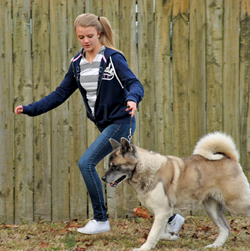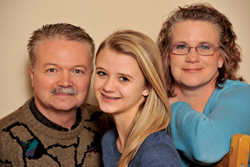 When McKenzie Dunford was 11, a sixth-grade classmate at her Hampton middle school poked her protruding shoulder blade and said, “Why’s that sticking out so far? You need to fix that.”
When McKenzie Dunford was 11, a sixth-grade classmate at her Hampton middle school poked her protruding shoulder blade and said, “Why’s that sticking out so far? You need to fix that.”
McKenzie was already wondering how her shoulder blade issue would affect her activities. By the time she reached middle school, she was taking dance lessons, showing dogs and playing softball and basketball. Inheriting a competitive streak from her mom, an ardent dog-show participant, and her dad, a former pitcher at Hampton’s Phoebus High School, McKenzie explains, “I wasn’t a girly girl, I will say that.”
Julie Dunford had introduced her daughter to dog shows when she was only 9 and barely weighed more than their prize Akita. McKenzie approached the competitions as she approached her other activities.
“When I’m in the show ring,” she says, “I don’t like to lose.” She seldom did. It didn’t hurt that she was lean and fit, with perfect posture.
When McKenzie started sixth grade in 2009, Julie mentioned to the school nurse that McKenzie’s shoulder blade had started to protrude. Julie recalls the nurse saying, “Oh, it’s scoliosis. It’s no big deal.”
As the school year progressed, McKenzie’s posture grew worse, with one shoulder noticeably lower than the other. By the time school let out for the summer, Julie and Joe Dunford were so concerned that they searched online for information about scoliosis. That led them to an appointment with pediatric orthopedic surgeon Sheldon St. Clair at his office in the CHKD Health and Surgery Center at Oyster Point.
The Dunfords had found the right place. Dr. St. Clair is the senior orthopedic and spine surgeon at CHKD and has performed hundreds of spine surgeries since the hospital opened its surgical suite in 1985. Since 2009, he has had a valuable teammate in those complex surgeries: CHKD neurosurgeon John Birknes. Dr. Birknes is one of a handful of pediatric neurosurgeons in the nation who has been specially trained to correct spinal deformities like scoliosis.
Scoliosis is a sideways curvature of the spine greater than 10 degrees, often accompanied by rotation to one side. It afflicts about 2.5 percent of the U.S. population, some 7 million people, and in most cases, the cause is unknown.
CHKD specialists treat children with scoliosis up to age 21. Congenital scoliosis appears as a birth defect in newborns. Early onset scoliosis afflicts children under 10, and adolescent scoliosis pre-sents itself in pre-teens and teens. For mild and moderate scoliosis, bracing can be the right treatment. But in the small number of cases in which the curvature exceeds 50 degrees, Dr. St. Clair says surgery is often the best option.
Julie feared that her daughter’s scoliosis resulted from something she had done, such as letting McKenzie carry heavy book bags or waiting too long to get treatment. At their first appointment, Dr. St. Clair assured Julie that she had done nothing to cause or worsen her daughter’s condition. Then he explained that only surgery could correct scoliosis as severe as McKenzie’s, which had reached 73 degrees.
 Surgical team gets McKenzie back in action
Surgical team gets McKenzie back in action
Before the surgery took place in October 2010, CHKD clinicians prepared the Dunfords for what was involved and encouraged them to write down questions. But nothing truly prepares a parent for a child’s surgery.
“When she was waiting to be taken back,” Joe recalls, “Dr. Birknes joked with her, trying to keep things light-hearted.” McKenzie wasn’t nervous, but Joe and Julie unraveled as doctors wheeled their only child into the surgical suite. Dr. St. Clair reassured them that a nurse would call every hour from the operating room with updates on McKenzie’s progress.
Although both parents knew their daughter was in good hands, it seemed to them as though time had stopped.
“That was the longest six hours of my life,” Joe says.
While her parents were pacing in the waiting room, the surgeons were teaming up in the operating room.
“John and I work extremely well together,” Dr. St. Clair says. “Spine surgery is very demanding physically and technically. No two cases are identical, and decisions have to be made before and during the surgery. These decisions are critical because they will affect our patients for the rest of their lives.”
Dr. Birknes explains that the two surgeons go back and forth as they operate, discussing different approaches. “Two brains and two sets of eyes and hands make for better decisions and outcomes,” he adds.
In McKenzie’s case, the first step was exposing her spine and methodically placing screws in the vertebrae for the rods that would hold the spine straight, correcting the curvature. During this process, some surgeons still awaken patients and ask them to wiggle their toes or fingers to confirm that nerves haven’t been damaged. But CHKD uses a more advanced method in which an electrophysiologist monitors nerve function during surgery.
After the screws were installed, the surgeons manually straightened McKenzie’s spine, paying close attention to the nerve function monitors. Then they secured the rods in place to keep the spine straight as the vertebrae fuse, a process that will maintain the correction for life.
While some scoliosis patients receive physical therapy in the hospital and even walk on the first post-op day, full recovery can take several months. For McKenzie, lack of use made her arms so weak she could barely push herself up. A CHKD physical therapist helped her rebuild her arm strength and increase the distance she walked each day.
McKenzie reached a physical milestone about six weeks after surgery, when the Wii Dance Revolution II came out. Missing her dance lessons, she worried that she wouldn’t be able to do it but said, “Mom, turn it on.” She took her first tentative dance steps, moving to the music. “It was like, ‘That was fun. Let’s do some more,’” she remembers.
Soon, she was tossing a softball with her dad. Last summer, when she handled her Akita at a dog show after turning 13, she came in first in a division that included 18-year-olds.
Today, McKenzie is back to dance lessons, softball games and other activities, with only a few restrictions.
“I don’t think she would ever jump out of an airplane,” Julie explains.
“I plan to do that,” McKenzie interrupts with a laugh. “That’s on my bucket list.”
Dr. St. Clair practices with CHKD Surgical Group’s Orthopedics and Sports Medicine. Dr. Birknes practices with CHKD Surgical Group’s Neurosurgery.
This story was featured in the Spring 2012 issue of KidStuff, a publication of Children's Hospital of The King's Daughters. Click to read more patients' stories.